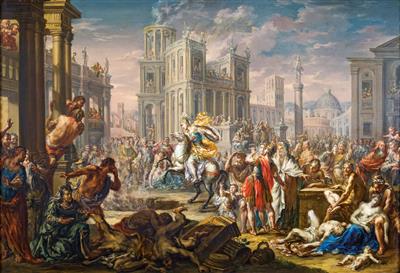Johann Georg Platzer

(Eppan 1704–1761)
Marcus Curtius,
signed lower right,
oil on copper, 41 x 59.5 cm, framed
Provenance:
Private collection, Turin
We are grateful to Christina Pucher for confirming the attribution of the present painting on the basis of high resolution photographs.
A crowded scene from Roman Republican history is represented in the present painting. Indeed, the ancient world was a source to which Johann Georg Platzer turned for many of his allegorical and history paintings. The legendary episode depicted here is recorded by Livy in his Annals: a great chasm opened up in the Roman Forum, which according to prophecy would only be closed if the Roman citizens would throw into it all that was most precious to them. Marcus Curtius, one of the most valiant soldiers of the Roman army, chose to throw himself into the abyss with great courage on horseback and dressed in armour, thereby saving Rome from being swallowed by the cataclysm.
In the present painting Platzer’s great technical skill and experience emerge: this is underlined by the picture’s copper support, which allows him to obtain bright colours and gradations of hues that give the surfaces an almost enamelled character.
The work is additionally characterised by its complex composition, as it is in the artist’s finest works. Many figures, arranged in the most disparate poses, crowd the scene. The architectural background is a mixture of elements derived from the architecture of ancient and papal Rome, and inspired by models taken from the North Italian tradition of quadratura or architectural painting. In the present painting, the two figures on the left that cling to a column to observe the scene, appear to recall the two individuals represented in a similar position in Raphael’s Expulsion of Heliodorus from the temple in the so-called Vatican Stanza di Eliodoro.
Indeed, the Renaissance tradition, as well as the Baroque and Flemish school, were important reference points for the artist’s formation. Platzer came from a family of artists in the Tyrol and his first training was with his step-father and then with his uncle. From the mid-1720s he resided in Vienna, where he was enrolled at the Akademie der Bildenden Künste, and where he remained for most of his life until his return to the Tyrol in the 1750s.
His production is above-all distinguished by small paintings, often on copper, such as the present work. Platzer was one of the leading exponents of the sophisticated Habsburg culture during the eighteenth century. His work was broadly esteemed for its pictoral quality combined with a sense of decorative style and pictorial virtuosity and an attention to detail, element that are evident in the present painting.
23.10.2018 - 18:00
- Realized price: **
-
EUR 149,400.-
- Estimate:
-
EUR 100,000.- to EUR 120,000.-
Johann Georg Platzer
(Eppan 1704–1761)
Marcus Curtius,
signed lower right,
oil on copper, 41 x 59.5 cm, framed
Provenance:
Private collection, Turin
We are grateful to Christina Pucher for confirming the attribution of the present painting on the basis of high resolution photographs.
A crowded scene from Roman Republican history is represented in the present painting. Indeed, the ancient world was a source to which Johann Georg Platzer turned for many of his allegorical and history paintings. The legendary episode depicted here is recorded by Livy in his Annals: a great chasm opened up in the Roman Forum, which according to prophecy would only be closed if the Roman citizens would throw into it all that was most precious to them. Marcus Curtius, one of the most valiant soldiers of the Roman army, chose to throw himself into the abyss with great courage on horseback and dressed in armour, thereby saving Rome from being swallowed by the cataclysm.
In the present painting Platzer’s great technical skill and experience emerge: this is underlined by the picture’s copper support, which allows him to obtain bright colours and gradations of hues that give the surfaces an almost enamelled character.
The work is additionally characterised by its complex composition, as it is in the artist’s finest works. Many figures, arranged in the most disparate poses, crowd the scene. The architectural background is a mixture of elements derived from the architecture of ancient and papal Rome, and inspired by models taken from the North Italian tradition of quadratura or architectural painting. In the present painting, the two figures on the left that cling to a column to observe the scene, appear to recall the two individuals represented in a similar position in Raphael’s Expulsion of Heliodorus from the temple in the so-called Vatican Stanza di Eliodoro.
Indeed, the Renaissance tradition, as well as the Baroque and Flemish school, were important reference points for the artist’s formation. Platzer came from a family of artists in the Tyrol and his first training was with his step-father and then with his uncle. From the mid-1720s he resided in Vienna, where he was enrolled at the Akademie der Bildenden Künste, and where he remained for most of his life until his return to the Tyrol in the 1750s.
His production is above-all distinguished by small paintings, often on copper, such as the present work. Platzer was one of the leading exponents of the sophisticated Habsburg culture during the eighteenth century. His work was broadly esteemed for its pictoral quality combined with a sense of decorative style and pictorial virtuosity and an attention to detail, element that are evident in the present painting.
|
Buyers hotline
Mon.-Fri.: 10.00am - 5.00pm
old.masters@dorotheum.at +43 1 515 60 403 |
| Auction: | Old Master Paintings |
| Auction type: | Saleroom auction |
| Date: | 23.10.2018 - 18:00 |
| Location: | Vienna | Palais Dorotheum |
| Exhibition: | 13.10. - 23.10.2018 |
** Purchase price incl. charges and taxes
It is not possible to turn in online buying orders anymore. The auction is in preparation or has been executed already.
